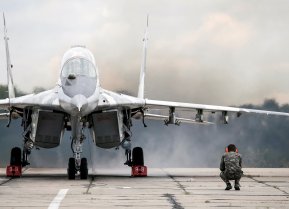Why Russia’s MiG-29 Fulcrum Never Lived Up to Its Full Potential
Reliability problems and more.
Here's What You Need to Remember: Unlike its higher-end Su-27 counterpart, the base MiG-29 configuration lacked a fly-by-wire system. The MiG-29 also boasted relatively low fuel capacity (resulting in a shorter range) and as little as six hardpoints, limiting its operational value in long-range and high-intensity combat missions.
Flown by everyone from the current President of Bulgaria to the Mongolian Air Force, the MiG-29 (NATO reporting name Fulcrum) remains among the most prolific fighters in the world. However, the Fulcrum suffers from a raft of technical shortcomings and design flaws that have made it an increasingly tough sell over similarly-positioned western and Russian alternatives.
The design foundation for the Mikoyan MiG-29 was conceived in the early 1970’s, in part, as the Soviet response to the emergence of the U.S. F-15 Eagle. The core concept was simple, yet convincing: the Soviet Air Force needed a modernized, cost-effective, workhorse multirole fighter to perform an eclectic mix of roles across the many proxy theaters of the Cold War. The MiG-29 seemed poised to fill this role with its 1982 introduction, boasting a swept back wing layout, long and thin fuselage, and ubiquitous bubble canopy. The MiG-29’s design prioritized high sustained top speeds—the original MiG-29 could reach a speed of Mach 2.5—and supermaneuverability, notably being one of a handful of 1980’s fighters capable of executing the technically demanding Pugachev’s Cobra maneuver.
There is little question that the MiG-29 did offer some tangible advantages over its F-15 rival. For one, it was arguably more maneuverable than its U.S. counterpart— particularly at slow speeds, and in the hands of an experienced pilot. It also boasted a helmet-mounted display, allowing it to fire its highly capable R-73 “Archer” missiles off-boresight; that is, the MiG-29 pilot is able to target enemy aircraft simply by looking at them within a specific range of view. It would take until the early 2000’s for the US Air Force to acquire parallel capabilities with the AIM-9X.
But the MiG-29 was held back by a host of crippling deficiencies. For one, the base model’s avionics package was woefully lacking. The MiG-29’s radar, navigation, and radar warning systems were anemic, potentially resulting in serious situational awareness issues. Former East German MiG-29 pilot Johann Köck noted that “the radar had reliability and lookdown/shootdown problems, hence its poor discrimination between targets flying in formation, and moreover it couldn’t lock onto the target in trail, only onto the lead.”
Unlike its higher-end Su-27 counterpart, the base MiG-29 configuration lacked a fly-by-wire system. The MiG-29 also boasted relatively low fuel capacity (resulting in a shorter range) and as little as six hardpoints, limiting its operational value in long-range and high-intensity combat missions. Even if these issues could have been overlooked in light of the MiG-29’s budget cost, the fighter has also incurred reliability concerns over the years—dozens of MiG-29 crashes and technical malfunctions have been reported in the prior decades, occasionally throughout entire export batches.
The MiG-29’s dozens of specialized variants have attempted to fix some of these problems, introducing more robust radars, a fly-by-wire system, aerial refueling, more sophisticated avionics, and additional hardpoints. The 2005 MiG-29M revision incorporated many of these improvements into a redesigned airframe.
Mikoyan is currently working on a deep MiG-35 modernization, adding more powerful RD-33MK engines, sophisticated ECM capabilities, greater range, and LCD display technology integrated throughout the controls. The first few serial MiG-35 units were delivered in 2019, with over a dozen more reportedly planned over the coming years.
Mark Episkopos is the new national security reporter for the National Interest.
Image: Reuters


